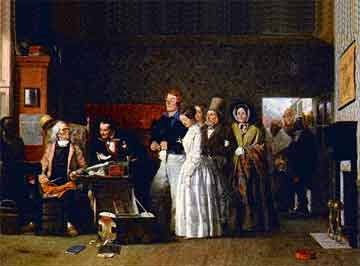Clothing in Antebellum America

In women's fashions, the high-waisted Regency gowns of the early decades of the century gave way to hourglass silhouettes and tight corsets. Paris was the center for women's fashions. Americaâs urban dressmakers modeled their clothes after Parisian fashion plates published in fashion magazines; while town and country seamstresses, in turn, copied urban creations. For men, London fashions were considered the epitome of good taste. Coats were made in dark colors, while vests (called waistcoats, as in Britain) were often bright or brightly decorated. Trousers were either black or light-colored, were close-fitting and were held up by suspenders. Materials for clothes and undergarments varied according to the climate and season. Materials like wool and cashmere were worn in cold weather, while warm weather brought clothing made from materials like cotton, linen and silk.
Both women and men generally wore shoes or boots, often brown or black, made of sturdy leather, suede or kid. Cloth was sometimes used, especially for womenâs formal slippers in warmer climates. Women wore elaborate hats, made or straw, or silk or satin. Menâs beaver hats fell out of favor, which cheaper hats made or straw or silk became popular. Until the late 1830s, men were usually clean-shaven. By the 1850s, however, few males past puberty could be found without facial hair. Beards, moustaches, and sideburns of many varieties became accepted as stylish signs of manliness.
On ordinary days, the wealthy and upper middle class wore simplified versions of their evening clothes. Working-class people wore much plainer, more durable clothes for daily living, saving their fancy clothes for religious services and for special social occasions. The poor, including African-American slaves, had to wear garments made of coarse, cheap material and designed for endurance rather than attractiveness or comfort.
 >
>